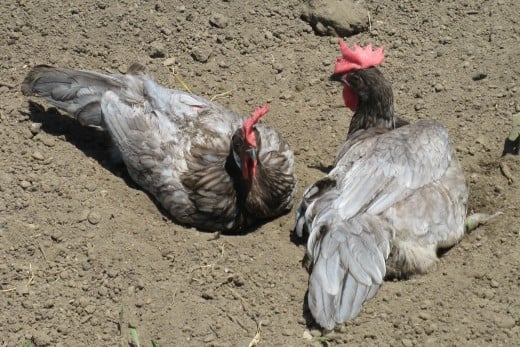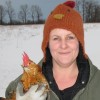Dust Bath in Your Henhouses - Why do Chickens need to Dustbath?

Most henhouses plans and information don't mention this juicy tidbit. A neat little dust-bath in the corner of the henhouse has a number of pleasant effects for your chickens. I am writing this to urge you to put a dustbath in each of your poultry coops and I will tell you why.
A dustbath for your chickens has a lots of subtle benefits that add up to healthy happy hens. Even if it weren't for the health benefits of reducing the parasite load, mite and lice, the sheer contentment they show while dustbathing is well worth it!
Benefits of Dustbathing
Encourages preening
By dust bathing, chickens remove dander, feather flakes and excess oils from their skin and feathers. This encourages preening. This is when the chickens will oil their feathers using the oil gland located on the top of the tail pad to help keep the feathers in good condition and waterproof.
Parasite control
Depending on the contents of the dust box, the powder or dust they bathe in may be harmful to parasites commonly found on chickens. By adding these organic powders, mites or lice can be controlled or reduced naturally.
Makes for content hens
This benefit is more subjective, but the ability to do this natural action for chickens must lead to healthier hens. If you ever watch hen dustbathing, they have a certain contentment to them, especially if they are relaxing in the sunshine. The fact the hens will line up to use it when new deeper dust is added speaks volumes.

How to Make a dustbath
How big?
Ours is 24" by 30" by 8" deep. Ideally the hens should have 6" deep of material to dust in, but they can make do with 4" if the level has gone down. Our dust bath is quite large and that bath would hold 4-5 hens at once for our coop of 80 hens. I wouldn't make one smaller than 2 feet by 18 inches, and that will serve most small flocks.
What materials?
The main thing is that it is heavy. The hens will often sit on the side of the dust box while deciding or waiting their turn to go in for a dip. They do not like things to tip up and probably won't go near it again after a scare.
You can make this from wood scraps left over from building your henhouses and nesting boxes. We make ours from a thick plywood base usually 3/4" and make the sides two 2 by 4's high. That thickness gives the weight and is thick enough if the hens roost on the side they will not damage their feet. If you want to use thinner wood for the bottom and sides (1 inch minimum), at least make the corners very heavy and solid to add that stabilizing weight.

What to fill it with?
-
Simplest and cheapest option is light dirt or sandy soil from the garden.
-
Soil with added sand to make it lighter
-
Sifted Cooled Wood Ash - inexpensive, caustic, organic and is harmful to parasites - we use this
-
Diatomacious earth (Dio) - these organic crushed fossilized diatoms are microscopically sharp. They cut the gut and kill any insect that ingests them including mites and lice. Not harmful to chickens but try to use dust mask when handling it. We use this if we run out of ash.
-
A non-organic carbaryl or other commercial dusting powder can be added to a soil mix if your chickens have severe parasite infestation. They know when they need to dust bath.

It is very important to have a dust bath in cold climates where hens may be inside for months on end in winter. Often after 2-3 months straight of being inside, the parasite load is high and can kill chickens by draining their blood and causing anaemia. If a hen goes off its legs and is too weak to move, you must check for lice or mites. Hopefully providing a dust bath will stop an infestation getting too far.
More sites and hubs we have written on chicken care
- Building Great Henhouses
- Easy Chickenry - Making life easier for the chicken keeper!
- 10 Ways to Keep Your Chickens Safe from Predators
- Plans for Building Easy Chicken Coops and Henhouses and Filling Them with the Right Chicken Breeds
- Top 10 Favourite Rare Heritage Chicken Breeds and Why!
- Tips on Buying Fertilised Chickens Eggs for Hatching & How to choose Chicken Incubators









